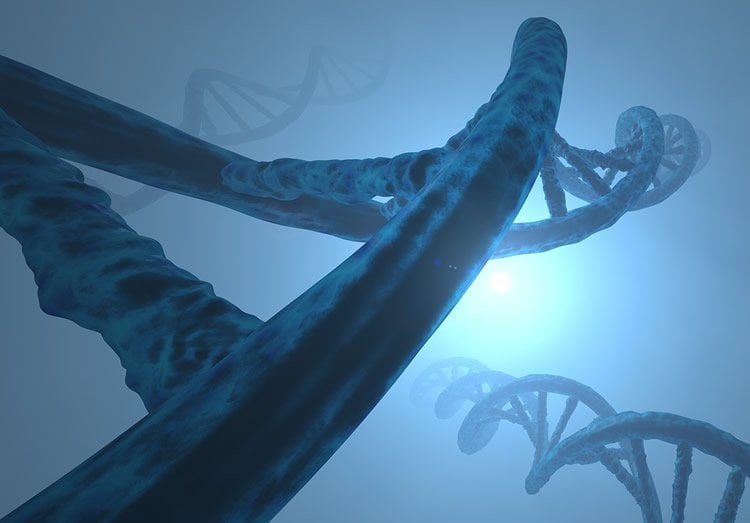Summary: Researchers have implicated a largely hidden part of the human genome in the severity of autism symptoms.
Source: University of Colorado.
Scientists at the University of Colorado Anschutz Medical Campus have implicated a largely hidden part of the human genome in the severity of autism symptoms, a discovery that could lead to new insights into the disorder and eventually to clinical therapies for the condition.
The researchers found the critical genes are part of the human genome that is so complex and difficult to study that it has been unexamined by conventional genome analysis methods.
In this case, the region encodes most copies of the Olduvai (formerly DUF1220) protein domain, a highly duplicated (~300 copies in the human genome) and highly variable gene coding family that has been implicated in both human brain evolution and cognitive disease.
The researchers, led by James Sikela, PhD, a professor in the Department of Biochemistry and Molecular Genetics at the CU School of Medicine, analyzed the genomes of individuals with autism and showed that, as the number of copies of Olduvai increased, the severity of autism symptoms became worse.
While the Sikela lab has shown this same trend previously, the discovery has not been pursued by other researchers due to the complexity of the Olduvai family.
“It took us several years to develop accurate methods for studying these sequences, so we fully understand why other groups have not joined in.” Sikela said. “We hope that by showing that the link with autism severity holds up in three independent studies, we will prompt other autism researchers to examine this complex family.”

In order to provide more evidence that the association with autism severity is real, the Sikela lab used an independent population and developed a different, higher resolution measurement technique. This new method also allowed them to zero in on which members of the large Olduvai family may be driving the link with autism.
Though autism is thought to have a significant genetic component, conventional genetic studies have come up short in efforts to explain this contribution, Sikela said.
“The current study adds further support to the possibility that this lack of success may be because the key contributors to autism involve difficult-to-measure, highly duplicated and highly variable sequences, such as those encoding the Olduvai family, and, as a result, have never been directly measured in other studies of autism,” Sikela said.
The study was published today in the American Journal of Psychiatry, and included CU Anschutz co-authors Jonathan M. Davis, PhD and Ilea Heft, PhD. Work was performed in collaboration with Dr. Stephen Scherer of The Hospital for Sick Children (SickKids) and University of Toronto and used whole genome sequences generated by the Autism Speaks MSSNG Open Science project.
Funding: The work was supported by grants from the National Institute for Mental Health (NIMH) and the Simons Foundation for Autism Research (SFARI).
Source: David Kelly – University of Colorado
Publisher: Organized by NeuroscienceNews.com.
Image Source: NeuroscienceNews.com image is in the public domain.
Original Research: Abstract for “A Third Linear Association Between Olduvai (DUF1220) Copy Number and Severity of the Classic Symptoms of Inherited Autism” by Jonathan M. Davis, Ph.D., Ilea Heft, Ph.D., Stephen W. Scherer, Ph.D., James M. Sikela, Ph.D. in American Journal of Psychiatry. Published February 15 2019.
doi:10.1176/appi.ajp.2018.18080993
[cbtabs][cbtab title=”MLA”]University of Colorado”Hidden Genes May Underlie Autism Severity.” NeuroscienceNews. NeuroscienceNews, 15 February 2019.
<https://neurosciencenews.com/asd-severity-genetics-10743/>.[/cbtab][cbtab title=”APA”]University of Colorado(2019, February 15). Hidden Genes May Underlie Autism Severity. NeuroscienceNews. Retrieved February 15, 2019 from https://neurosciencenews.com/asd-severity-genetics-10743/[/cbtab][cbtab title=”Chicago”]University of Colorado”Hidden Genes May Underlie Autism Severity.” https://neurosciencenews.com/asd-severity-genetics-10743/ (accessed February 15, 2019).[/cbtab][/cbtabs]
Abstract
A Third Linear Association Between Olduvai (DUF1220) Copy Number and Severity of the Classic Symptoms of Inherited Autism
Objective:
The authors previously reported that the copy number of sequences encoding an Olduvai protein domain subtype (CON1) shows a linear association with the severity of social deficits and communication impairment in individuals with autism. In this study, using an improved measurement method, the authors replicated this association in an independent population.
Method:
The authors obtained whole genome sequence (WGS) data and phenotype data on 215 individuals from the Autism Speaks MSSNG project. They derived copy number from WGS data using a modified sequence read-depth technique. A linear mixed-effects model was used to test the association between Olduvai CON1 copy number and symptom severity as measured by the Autism Diagnostic Interview–Revised. The authors then combined data from previous studies (N=524) for final analyses.
Results:
A significant linear association was observed between CON1 copy number and social diagnostic score (SDS) (β=0.24) and communicative diagnostic score (CDS) (β=0.23). Using the combined data, the authors present strong significant associations of CON1 dosage with SDS (β=0.18) and CDS (β=0.13). The authors also implicate Olduvai subtypes found in two genes, NBPF1 and NBPF14 (R2=6.2%). Associations were preferentially found in multiplex versus simplex families.
Conclusions:
The finding of a third dose-dependent association between Olduvai sequences and autism severity, preferentially in multiplex families, provides strong evidence that this highly duplicated and underexamined protein domain family plays an important role in inherited autism.







